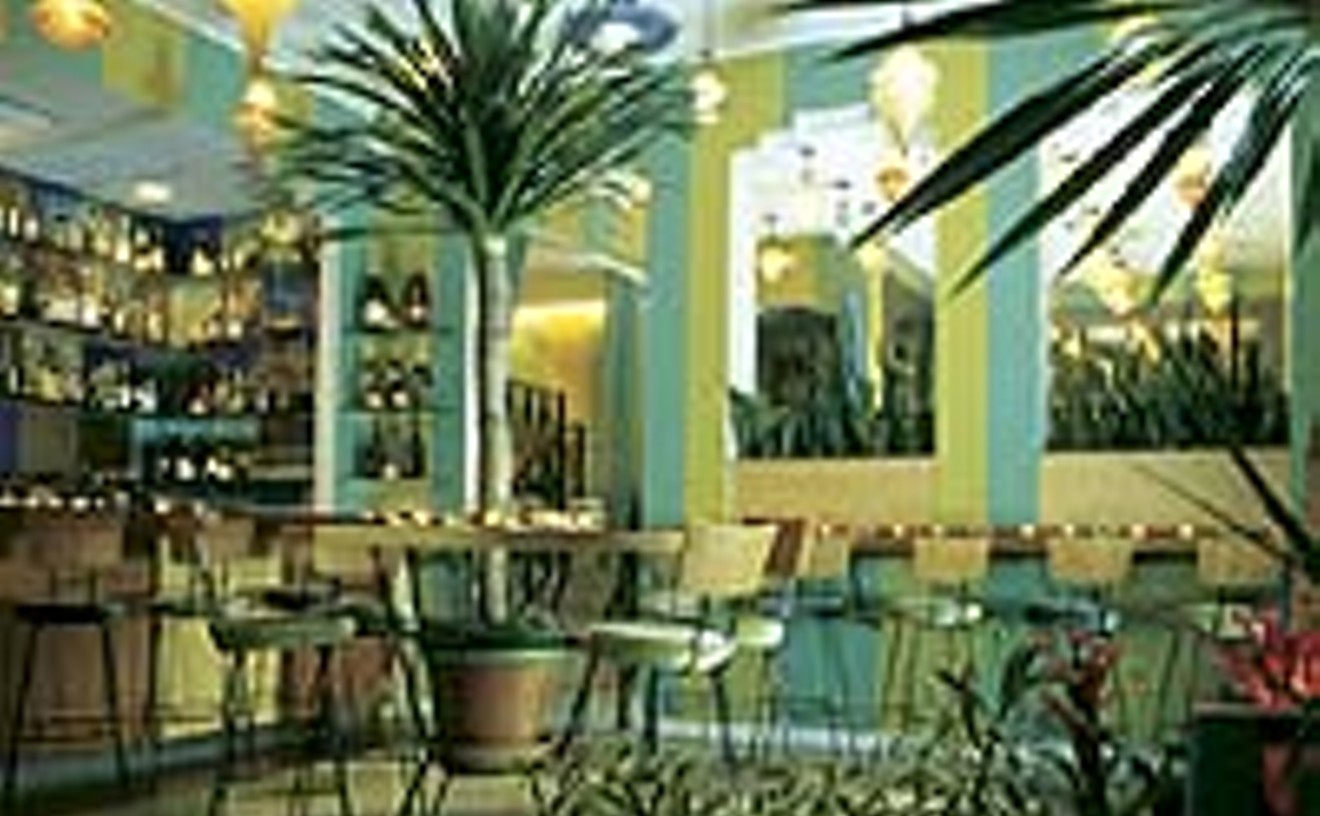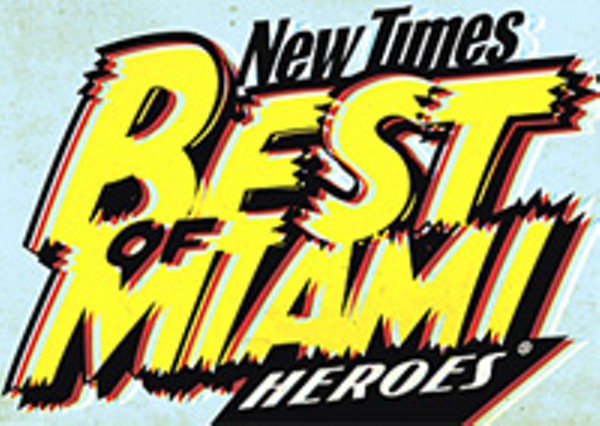Best Display of Wealth
CiFo

Until last year, the 1936 building that houses CiFo art space was just another in a long line of bleak industrial fa?ades in the desiccated cityscape of downtown Miami's warehouse district. Ella Fontanals Cisneros, CiFo's founder, commissioned architect René González to create a more appealing welcome mat for her gallery. González delivered: CiFo visitors are greeted by a capacious plaza, studded with bamboo plantings, beyond which lies a stunning custom-made mosaic composed of 4800 square feet of Bisazza glass tiles that suggest a tropical jungle glimpsed through mist. The gallery's interior is an austere industrial shell, its only flourish a high-sheen concrete floor, putting the emphasis on the contemporary Latin American art within. Cisneros founded the Cisneros Fontanals Art Foundation in 2002, the year after she divorced Oswaldo Cisneros, whose family is one of Venezuela's wealthiest. She also founded Miami Art Central, which opened in December 2003. MAC is merging with the Miami Art Museum, which will rise in Bicentennial Park (along with the Miami Museum of Science). The oasis she has bestowed on North Miami Avenue offers a glimpse of the new downtown Cisneros and her foundation aim to help create.
- 1018 N. Miami Ave., Miami, 33136 Map
- 305-455-3380
- www.cifo.org
Best Night at the Movies
Movies by the Bay

Photo by Richard Cavalleri/Shutterstock
Jostle your way through the box office and concession lines, and find a seat — if you arrive early enough — somewhere where you won't get whiplash. Try to ignore the crying baby, the ringing cellphone, the oblivious conversationalists behind you, the pounding noise from the action movie in the adjacent theater. Wait a minute — this is supposed to be best night at the movies, not typical night at the multiplex. Let's start over.Amble through Bayfront Park to Movies by the Bay, buy your ticket at the "box office" (it's actually a trailer; $9 for adults, $6 for children age five and up, $6 for seniors), grab a beach chair (there are 209 on site), and enjoy the bay breeze and glistening downtown backdrop. Movies by the Bay gets first-run films that cater to mass audiences (300) and families (Shrek the Third), but owners Bill and Susan Hertig also have the good taste to screen more refined offerings like Pan's Labyrinth and The Queen. The "concession stand" (also a trailer) offers the usual salty-sugary fare. They'll even give you something for free, something those multiplexes wouldn't dream of: mosquito spray.
- 301 Biscayne Blvd., Miami, 33132 Map
- 305-358-7550
- bayfrontparkmiami.com
Best Cuba Documentary
Casa de los Arabes
In the past year filmmakers have produced several notable documentaries about Cuba. Nat Chediak's Habana Abierta: Boomerang chronicled a Cuban rock band in exile, while Jauretsi Saizarbitoria and Emilia Menocal's East of Havana looked at inner-island democratization through hip-hop. But local filmmaker and cameraman John Maass's film Casa de los Arabes ("House of Arabs") stands out for its originality. Maass delved into unchartered territory when he followed Cuban-American belly dancer Tiffany Madera, a.k.a. Hanan, to Havana to document how she trained a group of Cuban dancers in the sensual ways of tummy twisting. Throughout the one-hour film, Maass examines the newly formed dance troupe, Grupo Aisha al Hanan, from its practice sessions at Casa de los Arabes, a Havana cultural center, to the streets of the Cuban capital, and on to dance competitions. As the women learn to transform their innate salsa-shaking rhythm into tight belly contortions, another transition takes place. Bodily movement becomes an emotional outlet in the day to day struggles of living under Cuba's tight political and economic system. At the same time the film subtly acknowledges the egalitarianism Cuban women enjoy in comparison to those in many Third World nations. Waving and spinning sheer, colorful veils around their sumptuous selves, these women explain that they're dancing for the liberation of those divas whose societies don't allow them such freedoms.
Best Hotel
The Hotel

For people, affiliation with a reality TV show can mean a real-world boost on the fame-o-meter. But what about buildings? Ask The Hotel, a South Beach wonder that has an interior designed entirely by current Bravo Top Design host and fashion/interior designer Todd Oldham. The historic Collins Avenue building known as "The Tiffany" was born in 1939 and gained fame when it was made pretty by Oldham in 1998 (and again in 2002). Oldham's influence has washed the hotel in a sea of bold colors that provide a distinctively cool atmosphere — so cool, in fact, that you feel like you're not cool enough to be there (kinda like reality TV). From hand-cut floor tiles, to tie-dye bath robes, to funky landscaping, Oldham did more than just lend his name and a few signature products. But if the prospect of anything reality TV-related makes you cringe, check out the rooms. They are cozy and chic — and the on-grounds restaurant Wish and rooftop bar Spire are the perfect spots to catch a bite, a drink, or a glimpse of the beautiful people. And there's not an elimination ceremony in sight.
- 801 Collins Ave., Miami Beach, 33139 Map
- 305-674-9474
- www.wishrestaurant.com
Best Movie Shot on Location
Cocaine Cowboys
Say hello to my leetle friend — a modest, homegrown documentary that tells the grisly tale of Miami's cocaine wars of the late Seventies and early Eighties with gusto. Scarface and Miami Vice ain't got nothin' on Cocaine Cowboys, which vividly — even gleefully —captures Miami in all the nutty, coke-fueled, gory glory of its drug-addled heyday. At times the doc seems as coked up as its interview subjects once were, and the soundtrack, by Vice themester Jan Hammer, does nothing to temper its generally cheesy production values. But director and producer Billy Corben has done his legwork, binging on vintage television footage and scoring key interviews with traffickers like Jon Roberts and pilot Mickey Munday. And the doc's most colorful underworld figure, the homicidal maniac Griselda Blanco, makes Tony Montana look like Mister Rogers. She's so juicy, in fact, the filmmakers have a sequel about her in the works: Cocaine Cowboys II: The Godmother Returns. We can't refuse!
Best Place to Donate Your Clothes
Rag Trade Happy Clothing Co.

Thrifting is a labor of love. Sometimes you spend hours sifting through forgotten garments to find that one item that's meant for you. Usually, though, thrifters go home either empty-handed or with a few threadbare fixer-uppers. But at Rag Trade, quality second-hand clothing is in abundance and therefore easy to find. It works like this: You can bring in old clothes and exchange them for money or store credit. Don't expect to reap loads of cash from your retired wardrobe, though — owner Stephanie Spiegel hand-picks items that are unique, and avoids name brands. Rag Trade is also a green business. In addition to selling recycled threads, the boutique offers a selection of new clothing from independent brands that use environmentally safe manufacturing practices. Customers can opt to forgo the bag for their purchases and donate the equivalent cost to an eco-friendly organization. Take a quick glance at prices (written on used party flyers) and you'll find skirts and shirts for eight dollars and pins for two.
- 4600 NE 2nd Ave., Miami, 33137 Map
- 305-573-1478
Best Fashion Designer
Ema Koja
Paris Hilton's brain might be void of any factual information, but the bimbette knows a thing or two about fashion. And it's not by accident that she's often snapped by the paparazzi sporting the wearable works of art spawned by the creative genius of one of the planet's hottest designers, Miami resident Ema Koja. Albanian-born Koja first burst into the public eye as a professional volleyball player in the Nineties. But soon after realizing she also had an aptitude for fashion design, she promptly stepped off the court and sat down behind a sewing machine. Conceptualized and created in her small Miami studio, Koja's line — Ema Savahl Couture — comprises feminine and alluring pieces that are all uniquely handpainted and accented. Designs, which will set you back a few hundred dollars, incorporate brush painting, silicone application, Swarovski crystals, glass beading, hand-dyed trims, and gold chain. In short, stunning. And her gorgeous gowns have shimmied, fluttered, and dazzled media on red carpets worldwide. What's good enough for Paris is good enough for Miami.
Best New Drama
Defining Code Red, by Justin Koren
Defining Code Red was the gutsiest play performed in South Florida this year, a drama that didn't so much penetrate the fourth wall as exist outside of it from the beginning, intersecting with its audience in dangerous and unpredictable ways. On the morning of February 3, 2004, seventh-grader Jaime Rodrigo Gough was stabbed to death in a bathroom at Southwood Middle School in Palmetto Bay. Justin Koren, a Southwood alum who was, at that time, building a theater career in New England and the U.K., got the news via e-mail and was instantly galvanized. Three years later, he had interviewed virtually everybody who had something to do with the event and who was willing to talk about it. Koren then distilled these debriefings into the haunting, unclassifiable Defining Code Red. It's not a finished work, one hopes — there are scenes that could do with some editing, and some that might benefit from getting scrapped altogether — but there are also scenes that you'll remember months later, more clearly and more powerfully than the intervening months themselves. When the action leaps from police station interrogations to the discovery of the boy in the bathroom; as it speeds up past the point of comprehension, the memories too adrenaline-drenched to properly order; as the names of all the country's dead kids are memorialized in a grisly faux-graduation — breaths catch, hearts break, and you are ashamed at your own ability to stay calmly seated. These are scenes so visceral and nakedly passionate that they could only have been drawn from life itself, and a standing ovation seems like a woefully inadequate response.
Best Live Theater
The Ziff Ballet and Opera House

Robin Hill
Architect Cesar Pelli's most famous creation may be the Petronas World Trade Center in Kuala Lumpur, for a time the world's two tallest buildings, but the Ziff Ballet and Opera House— one of two major performance venues at the Carnival Center for the Performing Arts — may be just as impressive. Thanks to Pelli, and to Russell Johnson of Artec Consultants, the place is a masterpiece of acoustical design. In Florida only Lakeland's Branscomb Auditorium is its equal — and that venue has a vastly less ambitious floor plan. To witness an opera at the Ziff is to hear qualities in the music that no performance at a lesser venue, and certainly no record, would ever lead you to suspect.
- 1300 Biscayne Blvd., Miami, 33132 Map
- 305-949-6722
- www.arshtcenter.org/
Best New Fashion Trend
305 Hats
Some of us Miami natives think that there should be a holiday on March 5 (3/05) every year, where we could put on our 305 hats and parade down Biscayne Boulevard chanting: "THREE-OH-FIVE!" That's right. 305 stayin' alive. This past year brought the NBA Championship for the Heat, and we became Super Bowl City once again. In music, Rick Ross busted out his new album Port of Miami, Trick Daddy showed us how to ride the Miami Donk, and Pitbull was given the title "Mr. 305." On TV, Miami Ink (where you can get a 305 tattoo) continues to show the beauty of our inhabitants and visitors. This is the Magic City, so wear your 305 hats with pride. The best place to purchase themç The USA Flea Market, located across from the Northside Metrorail station.





